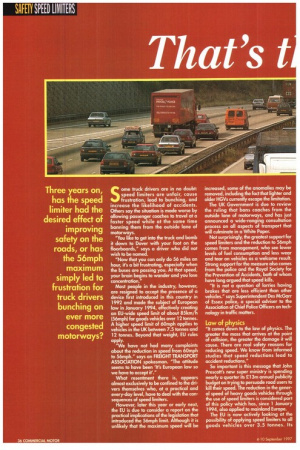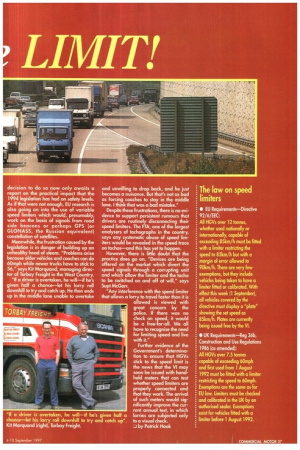AfEll PEED LIMITERS
Page 38

Page 39

If you've noticed an error in this article please click here to report it so we can fix it.
Three years on, has the speed limiter had the desired effect of improving safety on the roads, or has the 56mph maximum simply led to frustration for truck drivers bunching on ever more congested motorways?
Some truck drivers are in no doubt: speed limiters are unfair, cause frustration, lead to bunching, and increase the likelihood of accidents. Others say the situation is made worse by allowing passenger coaches to travel at a faster speed while at the same time banning them from the outside lane of motorways.
"You like to get into the truck and bomb it down to Dover with your foot on the floorboards," says a driver who did not wish to be named.
"Now that you can only do 56 miles an hour, it's a bit frustrating, especially when the buses are passing you. At that speed, your brain begins to wander and you lose concentration."
Most people in the industry, however, are resigned to accept the presence of a device first introduced in this country in 1992 and made the subject of European law in January 1994, effectively creating an EU-wide speed limit of about 85km/h (56mph) for goods vehicles over 12 tonnes. A higher speed limit of 60mph applies to vehicles in the UK between 7.5 tonnes and 12 tonnes. Beyond that weight, EU rules apply.
"We have not had many complaints about the reduction in speed from 60mph to 56mph." says an FREIGHT TRANSPORT ASSOCIATION spokesman. "The attitude seems to have been 'It's European law so we have to accept it'."
What resentment there is, appears almost exclusively to be confined to the drivers themselves who, at a practical and every-day level, have to deal with the consequences of speed limiters.
However, later this year or early next, the EU is due to consider a report on the practical implications of the legislation that introduced the 56mph limit. Although it is unlikely that the maximum speed will be increased, some of the anomalies may be removed, including the fact that lighter and older HGVs currently escape the limitation. The UK Government is due to review the ruling that bans coaches from the outside lane of motorways, and has just announced a wide-ranging consultation process on all aspects of transport that will culminate in a White Paper.
Not surprisingly, the greatest support for speed limiters and the reduction to 56mph comes from management, who see lower levels of fuel consumption and less wear and tear on vehicles as a welcome result. Strong support for the measure also comes from the police and the Royal Society for the Prevention of Accidents, both of whom have long argued that speed kills. "It is not a question of lorries having brakes that are less efficient than other vehicles." says Superintendent Des McGarr of Essex police, a special adviser to the Association of Chief Police Officers on technology in traffic matters.
Law of physics
"It comes down to the law of physics. The greater the mass that arrives at the point of collision, the greater the damage it will cause. There are real safety reasons for reducing speed. We know from informed studies that speed reductions lead to accident reductions."
So important is this message that John Prescott's new super ministry is spending nearly a quarter its £13m annual publicity budget on trying to persuade road users to kill their speed. The reduction in the general speed of heavy goods vehicles through the use of speed limiters is considered part of this policy which has, since 1 January 1994, also applied to mainland Europe. The EU is now actively looking at the possibility of applying speed limiters to all goods vehicles over 3.5 tonnes. Its
decision to do so now only awaits a report on the practical impact that the 1994 legislation has had on safety levels. As if that were not enough, EU research is alsoi Deecring on into the use of variable
limiters which would, presumably, work on the basis of signals from road side beacons or perhaps GPS (or GLONASS, the Russian equivalent) constellation of satellites.
Meanwhile, the frustration caused by the legislation is in danger of building up an unhealthy head of steam. "Problems arise because older vehicles and coaches can do 60mph while newer trucks have to stick to 56," says Kit Marquand, managing director of Torbay Freight in the West Country. "If a driver is overtaken, he will—if he's given half a chance—let his lorry roll downhill to try and catch up. He then ends up in the middle lane unable to overtake
and unwilling to drop back, and he just becomes a nuisance. But that's not as bad as forcing coaches to stay in the middle lane. I think that was a bad mistake."
Despite these frustrations, there is no evidence to support persistent rumours that drivers are routinely disconnecting their speed limiters. The FTA, one of the largest analysers of tachographs in the country, says any systematic abuse of speed limiters would be revealed in the speed trace on tachos—and this has yet to happen. However, there is little doubt that the practice does go on. "Devices are being offered on the market which divert the speed signals through a corrupting unit and which allow the limiter and the tacho to be switched on and off at will," says Supt McGarr. "Any interference with the speed limiter that allows a lorry to travel faster than it is allowed is viewed with great concern by the police. If there was no check on speed, it would be a free-for-all. We all have to recognise the need for limiting speed and live with it."
Further evidence of the Government's determination to ensure that HGVs stick to the speed limit is the news that the VI may soon be issued with handheld meters that can test whether speed limiters are properly connected and that they work. The arrival of such meters would significantly improve the current annual test, in which lorries are subjected only to a visual check.
_I by Patrick Hook
The law on speed limiters
• EU Requirements—Directive 92/6/EEC: All HGVs over 12 tonnes, whether used nationally or internationally, capable of exceeding 85km/h must be fitted with a limiter restricting the speed to 85km/h but with a margin of error allowed to 90km/h. There are very few exemptions, but they include vehicles being taken to have a limiter fitted or calibrated. With effect this week (1 September), all vehicles covered by the directive must display a "plate" showing the set speed as 85km/h. Plates are currently being issued free by the VI.
• UK Requirements—Reg 36b, Construction and Use Regulations 1986 (as amended): All HGVs over 7.5 tonnes capable of exceeding 60mph and first used from 1 August 1992 must be fitted with a limiter restricting the speed to 60mph. Exemptions are the same as for EU law. Limiters must be checked and calibrated in the UK by an authorised sealer. Exemptions exist for vehicles fitted with a limiter before 1 August 1992.








































































































